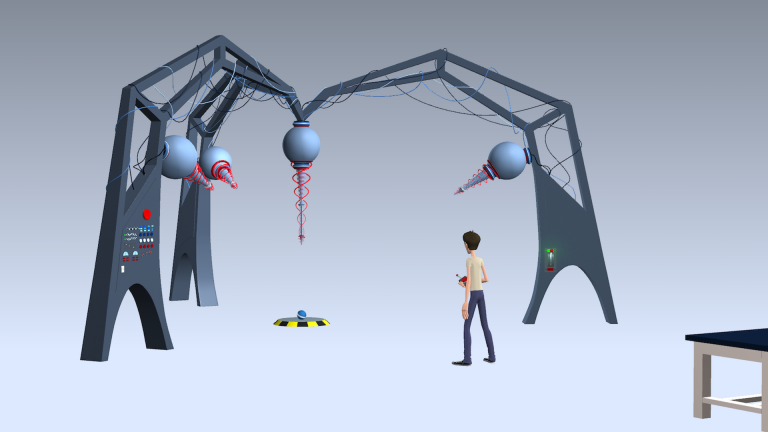
Carson School senior’s short animated film on film festival circuit
calendar icon26 Feb 2020 user iconBy Kathe C. Andersen

Lincoln, Neb.--“Irritable Ball Syndrome,” a five-minute advanced animated film project by film and new media senior Brady Glover, has been winning recognition at several film festivals recently.
The film has been accepted into eight film festivals, winning awards at the Anim8 Student Film Festival and Oneota Film Festival. Other festivals it has been accepted into include the Toronto Animation Arts Festival International, Love Your Shorts Film Festival, Prisma Independent Film Awards, ICONA Festival, DAE Studio International Film Festival and the upcoming Omaha Film Festival in March.
“It’s cool that it’s being recognized,” Glover said.
Associate Professor of Virtual Production, Interactive Media and Cinematic Arts Steve Kolbe is not surprised by Glover’s success with the project.
“Brady is a special student. He is—and will be—successful,” Kolbe said. “He has talent, of course. But that talent is born out of determination and tenacity. It is a direct product of his passion, work ethic and consistent drive to improve. Brady is always enhancing his skill sets through hard work and feedback. He is not afraid to showcase to others in order to learn from their comments. These are all admirable traits to any employer. However, arguably his best characteristic is his willingness and ability to mentor others—to share his knowledge and to help others improve along with him.”
The project pushed Glover.
“We can do an advanced project for our junior year at school, and I wanted to do something more ambitious that I haven’t done before previously,” Glover said. “Doing an animated short is a lot, but I’ve been taking Steve’s animation classes and doing stuff on my own here and there to experiment with 3D any way I can. I thought it’d be fun to try an animated short and push myself and see what my limits are—and I definitely did that.”
His original idea for the concept was to have a man switch places with his dog. Eventually he simplified the concept. The description of his short reads: “When a scientist tries to infuse life into a ball, he learns how to roll with what life zaps at him.”
“It became a scientist switching places with a ball, which is very simple. It’s only one character, one set and a ball,” Glover said. “The idea intrigued me on just switching places with something else. It was fun to play around with.”
He began the project in the spring of 2018 and completed it last spring. He completed much of the work himself, including directing, writing and 3D animation.
“And then the fun began where I was constantly in the lab just grinding away and animating,” Glover said. “This was a grind. It was a lot. I think I had 88 shots total. Twenty-five of them were with the human character, and that’s what took the majority of the time. I think it was almost three months for animation, in general. But yeah, I was in the lab constantly, every single day. If I wasn’t doing anything, I was animating.”
But he enjoyed it.
“It was a good grind,” he said. “I was pushing myself and finding out what I can really do with things.”
After completing the animation, he moved into lighting the 3D space, rendering and other post-production work.
“I had no knowledge of 3D lighting before,” he said. “Steve gave me a book, and he told me about stuff that has worked before in productions. I got a general idea, and then I just kind of had to go for it.”
He appreciates the support from faculty and students in the Carson School.
“I am truly thankful for each student and faculty member that helped make this story come to life,” he said. “This animation wouldn’t be as successful if I didn’t have their help and support.”
Now that it’s complete and doing well on the film festival circuit, Glover can appreciate what he created.
“It’s nice that audiences can enjoy what I’ve been working so long on,” he said. “Even if it doesn’t get accepted into places, people are still seeing it. It’s great that it is winning awards, but the thing that matters most to me is that people are enjoying it.”
He also learned a lot about the animation process working on this animated short.
“The idea of making an animated short is very intriguing,” Glover said. “I had a good understanding that it was going to take a lot of time to do it, but I did not have an idea of what all went into it. I did animation and modeling in Steve’s classes. Storyboarding a short story, layout, lighting and rendering were all new. Going through this process with the support from Steve, I can understand how the production pipeline works at animation studios. I’m glad I went through it.”
His love for animation began at an early age.
“When I was very young, I was always intrigued by animations and how they worked and what went into it,” he said. “I’d do these little 2D stick cartoons, and looking back now, they are terrible. But it helped me understand movement in animation at a young age.”
In high school, he downloaded Blender, a free 3D software, to learn how to model and animate.
“It was fun,” he said. “I made this sloth character, and he had hair and was rigged to move. It was cool seeing what I could do from only watching tutorials on YouTube.”
That led him to study film and new media in the Johnny Carson School of Theatre and Film, where he was able to take some animation courses and learn from Kolbe.
“There’s so much you can learn from classes, but the most you’re going to learn is making these connections with the faculty,” he said.
He has worked with Kolbe on the Virtual Reality project with NET to recreate University Hall. He also had an internship at the University of Nebraska Medical Center’s Munroe-Meyer Institute, where he created a simulated hair salon for people with autism.
“They’re making VR games and simulations for people with disabilities, and this brought a whole new aspect of 3D that I didn’t know was out there,” Glover said. “You can actually help people hopefully get through therapy a lot easier by making these cool 3D worlds. Hopefully by putting them in this virtual world, we can help them ease into it. It’s neat that the work I love to do can inspire or impact someone else positively—which is very meaningful.”
Glover likes animation because of the endless creativity.
“There’s so much creativity to it,” he said. “There’s really no limit to what you can do in animation. You can build a futuristic machine that can turn a man into a ball, or you can do something realistic like making a hair salon. Anything you can see in the real world, but times that by whatever you can imagine. That’s very appealing.”
But it’s also about storytelling.
“You’re telling stories that audiences of all ages can enjoy, but the possibility of having a deeper meaning is very intriguing,” Glover said. “I really like Pixar animations because they’re very heartwarming. The younger audiences can enjoy it, but I feel like the adults can take away more from them. That’s something I want to try to do wherever I end up.”